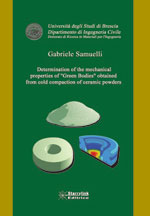Autore: Gabriele Samuelli
Titolo
Determination of the mechanical properties of green bodies obtained from the cold compa-ction of ceramic powders
Collana Tesi e ricerca
Genere: Ingegneria civile
This thesis is concerned with the determination of the mechanical properties of components produced by cold compaction of ceramic powders, the so-called “green bodies”. The considered material is in the intermediate stage of an industrial process for the production of advanced ceramics. The starting point is a ceramic powder cold-compacted to the desired shape (stage I). Possibly, after finishing processes, the material undergoes the sintering process (stage II) at high temperature, approaching its melting point, where the material keeps den-sifying up to the solid state density.
The success of the entire production process is strictly related to the mechanical properties of the green body. The material, at the end of the shaping process, has to be sufficiently tough to be handled. Moreover, an excessive lack of homogeneity of the green body, due to an unsuitable geometry of the die, or an incorrect amount of additives, or to particle-particle as well as particle-die friction, may lead to shape distortion during the sintering process, requiring expensive machining operations. The finite element simulation is, in principle, a useful and effective tool to predict the mechanical properties of the green body at the end of the compaction process and, thus, to optimize the production process. A constitutive model, descri-bing the evolution of the mechanical properties of the green body during the consolidation stage, must be defined.
In this thesis, we propose and implement, in the framework of the finite element method, a pheno-menological constitutive model for the cold com-paction of ceramic powders (stage I), accounting for some so far almost disregarded aspects of the process: the cohesion gain of the powder aggregate, the evolution of the elastic properties as well as the elastic and plastic anisotropy induced by a non-isotropic compaction process.


